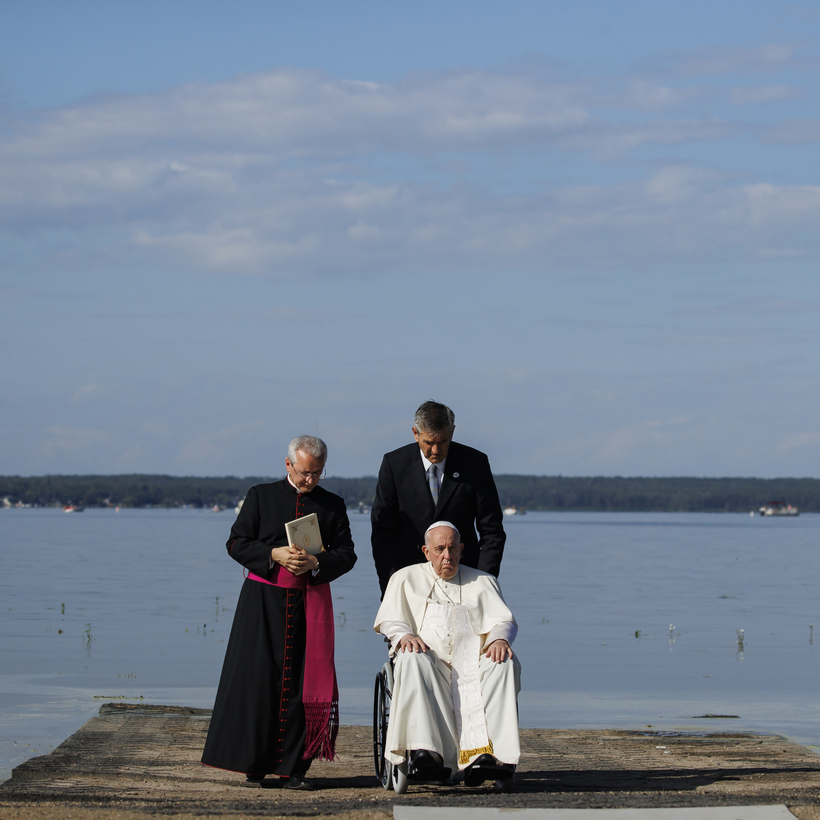The opening tableau of a recent New York Times piece about Pope Francis’s self-described “penitential pilgrimage” through Canada, which concluded this past weekend, captured the atmospherics well. Francis spoke “in a pow wow circle, a covered ring surrounding an open space used for traditional dancing and drumming circles,” surrounded by “teepees, campfires and booths labeled ‘Mental Health and Cultural Support.’”
He was in Canada, as he put it, to “humbly beg forgiveness for the evil committed by so many Christians against the Indigenous peoples,” with reference to what the piece’s lede characterized as “church-run residential schools that became gruesome centers of abuse, forced assimilation, cultural devastation and death for over a century.”

The Pope would almost certainly not be making his apology tour had it not been for a frenzy, originating with a 2021 story in The New York Times, that consumed Canadian and world media last summer. (In fact, the Pope had turned down a request from Justin Trudeau for an apology in 2018.) Headlined ‘Horrible History’: Mass Grave of Indigenous Children Reported in Canada, the article incited a season of breast-beating and genuflection from Canadian politicians and institutions, and a wave of protest that resulted in the toppling of statues and the torching of dozens of Canadian churches.
The spiritual leader of the Catholic Church was not there to apologize for systematic mass murder, or “Canada’s Holocaust moment”—all terms placed into circulation by a media which, as the veteran Canadian journalist Terry Glavin, writing on his Substack, put it, engaged in “breathlessly banner-headlining ‘discoveries’ of graves that were not discovered, attributing to local indigenous leaders shocking claims they did not make, reporting announcements that Indigenous leaders did not announce, and then more or less ignoring those leaders when they tried to set the record straight.”
Above all, Francis was not there to confront the discovery of a “mass grave” at Kamloops, once the largest residential boarding school in Canada, in the summer of 2021. Though the term was emblazoned across a May 28 New York Times headline that stoked the ensuing media frenzy, no such discovery happened. “This is not a mass grave,” as Rosanne Casimir, the leader of the First Nations tribe, said in early June, “but rather unmarked burial sites that are, to our knowledge, also undocumented.” Yet the original New York Times story remains uncorrected.

There never was any allegation of a pit or trench into which bodies were stacked. There was instead the discovery using “ground-penetrating radar” of regularly spaced disturbances in the soil that one expert said were consistent with unmarked burial sites, which were in turn consistent with claims made by former students. Determining whether the disturbances were in fact bodies required excavation which, more than a year after the initial findings, still has not been done. That they were likely to be bodies is quite distinct from the assertion, pervasive throughout the media, that the remains of 215 children had already been found. Skeptics of the discovery have speculated that the disturbances in the soil could be the result of root movements. Whatever the case, we won’t know for sure until the earth is peeled back.
We therefore have a story of a reckoning with the brutal legacy of colonialism driven by a media, a political class, and a public unwilling or unable to distinguish between very disturbing events, such as those that happened within the residential-boarding-school system, from history’s worst atrocities, which this was not.
One felt that the gravesite story was sensationalized to satisfy a need for Canadians to emulate their great neighbor to the south and experience their own paroxysms of self-denunciation and cleansing violence over race and history. It is also an object lesson in the disturbing ease with which the term “cultural genocide” slides all too easily into the unqualified “genocide.” Though the repetition of the term makes the conflation all too easy, this is very much a distinction with a difference.

The Pope himself added to the confusion between the terms when he used the word “genocide” in response to a question from an Indigenous reporter on his return flight to Rome before going on to condemn “taking children away and trying to change their culture, their minds, change their traditions, a race, an entire culture,” which is to say, cultural genocide.
The article incited a season of breast-beating and genuflection from Canadian politicians and institutions, and a retaliatory wave of protest that resulted in the toppling of statues and the torching of dozens of Canadian churches.
The actual evils for which the Church, along with the Canadian government, bears responsibility have been thoroughly documented by a Canadian-government Truth and Reconciliation Commission, whose work was completed in 2015. Foremost among these evils was the founding objective of Canada’s aboriginal policy itself, which a six-volume history published by the commission described thusly: “Through a process of assimilation, cause Aboriginal peoples to cease to exist as distinct legal, social, cultural, religious, and racial entities in Canada.” The report goes on to characterize this process as “cultural genocide,” which it defines as “the destruction of those structures and practices that allow the group to continue as a group.” (The report contrasts this process with “physical genocide,” the destruction of the group itself.)
In practice, this meant forcibly separating 150,000 Indigenous children from their parents and placing them into some 139 boarding schools that operated in Canada between 1831 and 1996, where they were subjected to, as a 2018 history called it, “the full indoctrination of the children into Christian beliefs and customs—to kill the Indian in the child.” As at other Catholic schools during the period, a number of students were sexually abused.

Accidents, fire, malnutrition, and disease resulted in a higher rate of death for residents of these sub-par, inadequately funded and regulated facilities than for the general school-age population. The schools did not send back the bodies of dead children to their home communities for most of their history, instead burying them in the schoolyards, and preserved a fragmentary record of the deaths, leaving fully 32 percent of the 3,200 deaths identified on a register compiled by the Truth and Reconciliation Commission unnamed. The cemeteries were in many cases abandoned, leaving behind unmarked graves that in one case of water erosion in 1996 resulted in the discovery, exhumation, and re-burial five years later of 34 bodies at a boarding school in Alberta.
The attempt to document all student deaths in the residential schools is by no means complete, and the figure is likely to grow as additional records emerge, particularly those requested from and not yet provided by the Catholic Church, which ran approximately two-thirds of the schools. The commission noted further that a painstaking, costly effort of actually finding the bodies lay ahead, one that subsequent reporting has shown to be halting, obstructed by bottlenecks in funding and coordination of the search, which requires the cooperation of a web of tribal authorities and government and non-governmental agencies. The use of ground-penetrating radar at Kamloops is an early instance of the decades-long project, and there will be many more such discoveries in the years to come.
This history has been well known since 2015 and did not have the power to summon the Pope from Rome. What summoned him to these shores was the media frenzy that bundled plenty of good reporting with hysterical nonsense. Likewise, funding for the search for bodies, which the federal government had been slow in providing, instantly materialized in the millions. We all saw the efficacy of world-historical hyperbole in opening the spigots, and no doubt more of it will be similarly incentivized in the years to come.
Wesley Yang is the author of The Souls of Yellow Folk. You can read his Substack here


